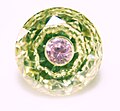Goaboabanga
Goaboabanga are an artform originating in Dezevau, characterised by additive metalworking, stoneworking and woodworking and used for symbolic and self-expressive purposes. It can be considered a form of sculpture or handicraft, and is characteristically geometric and abstract rather than depictive; they almost always have at least one axis of symmetry, and often more. Goaboabanga not made for symbolic purposes tend to be more complex in design. It is believed to have originated in the first millennium BCE, where goaboabanga were hung on trees and houses for superstitious, signage or decorative reasons; while this is still practiced, goaboabanga are also used in stylised form as symbols or emblems, as keystones on arches and in jewelry. Their modern name comes from the Ziba goaboa meaning "circle" and banga meaning "symbol", referring to their circular shape and their symbolism.
Blazon
A system of blazon or crafting shorthand is used to describe goaboabanga; as they tend to be geometric and symmetrical, this is often achievable with relatively few words. Accurate description enables their reproduction from place to place and from time to time, and prevents duplication of a goaboabanga as a symbol for more than one thing, place, person or group.
Materials
While a wide range of materials may be used in the creation of goaboabanga, for symbolic purposes they can be generalised to a few. Materials often used include gold, silver, iron or steel, brass, ebony, ivory, wood, bone, lapis lazuli, ruby, diamond, emerald, sapphire, jade, amethyst, citrine, basalt, bluestone, marble, sandstone, clay and soapstone. In the modern day, some materials have been added to the set, such as aluminium and plastic. These materials are classified, generally, according to their colour and pattern; of gems (transparent materials generally, so including amber and glass), there are white, black, red, blue, green, purple, yellow-orange (sometimes separated, especially in the modern day) and cyan; of metals (opaque lustrous materials generally, so including some plastics in the modern day) there are white, yellow, orange, sometimes blue, green or red; of wood there are white, red, black, yellow-orange, and of stone white, black, red, blue, green, purple, yellow, orange and cyan.
Manufacture
Goaboabanga are traditionally handmade by artisans, but many are mass-produced where there is a market for them (e.g. the Dezevauni one).
Usage
Goaboabanga are highly symbolic, and many countries, geographical subdivisions and organisations have them. It is common to build a decorative gate to places with a goaboabanga as or on the keystone of the arch to symbolise the place. It was also formerly more common practice to hang many miniatures on trees to mark territory; this was done as the highly forested terrain typically obstructed views. Goaboabanga are also merely self-expressive, decorative art, and composition of them is regarded similarly to other creative arts; some creatively made goaboabanga are purchased to use as symbols, and their designs are recognised as intellectual property under Dezevauni law. They are common as badges, buttons or jewelry such as on rings or necklaces both as art and as symbols. It is also not uncommon to collect goaboabanga miniatures, which might be either purchased or made. Before the advent of modern warfare, they were common on weapons, armour and otherwise as sigils on the field of battle.
It is and was not unknown, but generally rare for families to pass them down. The more common practice is for an individual to create their own, though it is and was much more common for certain motifs to be passed down in the family.
Goaboabanga, along with other household objects, have historically been found in graves as far as Djedet.












